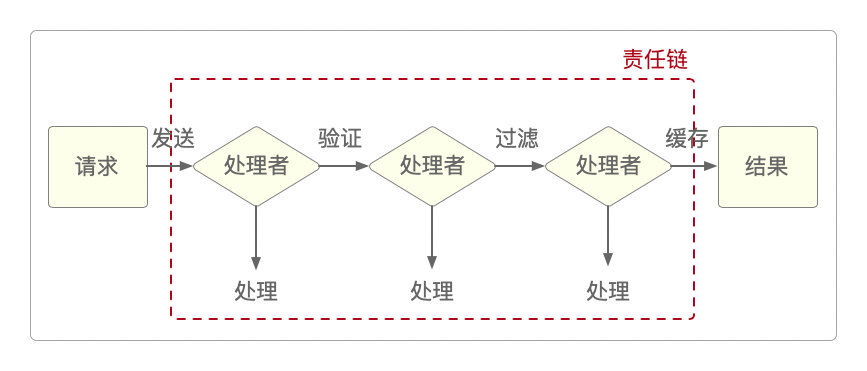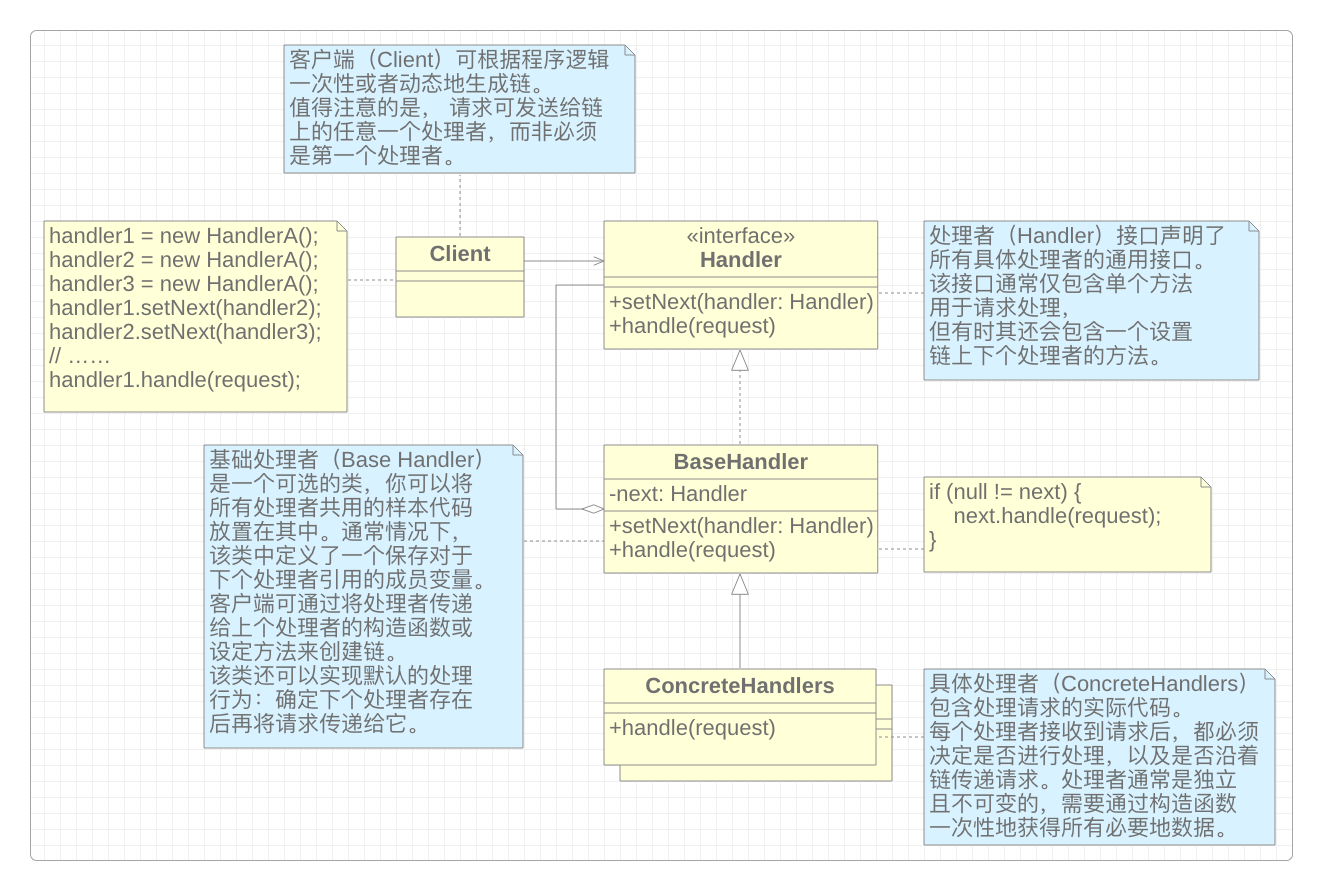责任链模式(行为型模式)
模式概述
责任链模式是一种行为设计模式,它可以将请求沿着处理链条发送。
收到请求后,每个处理者均可对请求进行处理,或将其传递给链上的下一个处理者。
问题
某公司正在开发一款在线订购系统,希望对系统访问进行限制,只允许认证用户创建订单,而有管理权限的用户则拥有订单的完全访问权限。
这些检查必须依次进行,只要有用户凭据输入,系统就会尝试对用户进行认证。
但系统需求总是在不断变化,在此期间增加了好几个后续步骤:如验证、过滤、缓存等。
这让代码混乱不堪。
方案
责任链模式建议将这些处理者连成一串链条,链条上的每个处理者都保存有下一处理者的引用。
除了处理请求外,处理者还负责沿着链传递请求。请求会在链上移动,直至所有处理者都有机会对其进行处理。
在上面的订购系统中,处理者会在处理完毕后决定是否继续沿着链传递请求。所有处理者都将执行自己的主要行为,无论该行为是身份验证还是数据缓存。

结构

实现
Java
/**
* 处理抽象类
*
*/
public abstract class Handler {
private Handler next;
public static Handler link(Handler first, Handler... chain) {
Handler handler = first;
for (Handler nextInChain: chain) {
head.next = nextInChain;
head = nextInChain;
}
return first;
}
public abstract boolean check(String email, String password);
protected boolean checkNext(String email, String password) {
if (next == null) {
return true;
}
return next.check(email, password);
}
}
/**
* 处理数量限制
*
*/
public class ThrottlingHandler extends Handler {
private int requestPerMinute;
private int request;
private long currentTime;
public ThrottlingHandler(int requestPerMinute) {
this.requestPerMinute = requestPerMinute;
this.currentTime = System.currentTimeMillis();
}
public boolean check(String email, String password) {
if (System.currentTimeMillis() > currentTime + 60_000) {
request = 0;
currentTime = System.currentTimeMillis();
}
request++;
if (request > requestPerMinute) {
System.out.println("请求被限制");
Thread.currentThread().stop();
}
return checkNext(email, password);
}
}
/**
* 处理登录信息
*
*/
public class UserLoginHandler extends Handler {
private Server server;
public UserLoginHandler(Server server) {
this.server = server;
}
public boolean check(String email, String password) {
if (!server.hasEmail(email)) {
System.out.println("邮件未被注册");
return false;
}
if (!server.isValidPassword(email, password)) {
System.out.println("密码错误");
return false;
}
return checkNext(email, password);
}
}
/**
* 授权目标
*
*/
public class Server {
private Map<String, String> users = new HashMap<>();
private Handler handler;
public void setHandler(Handler handler) {
this.handler = handler;
}
public boolean login(String email, String password) {
if (handler.check(email, password)) {
System.out.println("授权成功");
// ......
return true;
}
return false;
}
public void register(String email, String password) {
users.put(email, password);
}
public boolean hasEmail(String email) {
return users.containsKey(email);
}
public boolean validPassword(String email, String password) {
return users.get(email).equals(password);
}
}
/**
* 客户端
*
*/
public class Client {
private static BufferedReader reader = new BufferedReader(new InputStreamReader(System.in));
private static Server server;
private static void init() {
server = new Server();
server.register("admin@example.com", "123456");
server.register("user@example.com", "654321");
Handler handler = Handler.link(
new ThrottlingHandler(2),
new UserLoginHandler(server)
);
server.setHandler(handler);
}
public static void main(String[] args) throws IOException {
init();
boolean success;
do {
System.out.print("输入邮件:");
String email = reader.readLine();
System.out.print("输入密码:");
String password = reader.readLine();
success = server.logIn(email, password);
} while (!success);
}
}Go
package main
import "fmt"
/**
* 部门处理者接口
*
*/
type Department interface {
execute(*Patient)
setNext(Department)
}
/**
* 具体处理者:前台
*
*/
type Reception struct {
next Department
}
func (r *Reception) execute(p *Patient) {
if p.registrationDone {
fmt.Println("患者登记已完成")
r.next.execute(p)
return
}
fmt.Println("接收患者登记")
p.registrationDone = true
r.next.execute(p)
}
func (r *Reception) setNext(next Department) {
r.next = next
}
/**
* 具体处理者:医生
*
*/
type Doctor struct {
next Department
}
func (d *Doctor) execute(p *Patient) {
if p.doctorCheckUpDone {
fmt.Println("医生检查已完成")
d.next.execute(p)
return
}
fmt.Println("医生检查患者")
p.doctorCheckUpDone = true
d.next.execute(p)
}
func (d *Doctor) setNext(next Department) {
d.next = next
}
/**
* 具体处理者:药房
*
*/
type Medical struct {
next Department
}
func (m *Medical) execute(p *Patient) {
if p.medicineDone {
fmt.Println("已给患者开药")
m.next.execute(p)
return
}
fmt.Println("开药给患者")
p.medicineDone = true
m.next.execute(p)
}
func (m *Medical) setNext(next Department) {
m.next = next
}
/**
* 具体处理者:收银
*
*/
type Cashier struct {
next Department
}
func (c *Cashier) execute(p *Patient) {
if p.paymentDone {
fmt.Println("已付款")
}
fmt.Println("患者支付现金")
}
func (c *Cashier) setNext(next Department) {
c.next = next
}
/**
* 患者
*
*/
type Patient struct {
name string
registrationDone bool
doctorCheckUpDone bool
medicineDone bool
paymentDone bool
}
/**
* 客户端
*
*/
func main() {
cashier := &Cashier{}
// 药房的下一个是收银
medical := &Medical{}
medical.setNext(cashier)
// 医生的下一个是药房
doctor := &Doctor{}
doctor.setNext(medical)
// 前台的下一个是医生
reception := &Reception{}
reception.setNext(doctor)
patient := &Patient{name: "abc"}
// 患者就诊
reception.execute(patient)
}适用场景
当需要使用不同方式处理不同种类请求,而且请求具有一定顺序且类型未知时,可以使用责任链模式。
如果所需处理者及其顺序需要在运行时进行改变,可以使用责任链模式。
优缺点
责任链模式的优点。
可对发起操作和执行操作的类进行解耦,符合
单一职责原则。可以在不更改程序的情况下新增处理者,符合
开闭原则。可以控制请求处理的顺序。
责任链模式的缺点。
- 部分请求可能永远不会被处理。
相关性
责任链模式、命令模式、中介者模式和观察者模式都用于处理请求发送者和接收者之间的不同连接方式。责任链模式的管理者可使用命令模式实现,此时可以对请求代表的同一个上下文对象执行许多不同的操作。责任链模式通常和组合模式结合使用:当叶子组件接收到请求后,可将请求沿包含父组件的链条一直传递至树根。责任链模式和修饰器模式的类结构比较相似。两者都将需要执行的操作传递给一系列对象。但区别在于责任链模式可以相互独立地执行所有操作,还可以随时停止传递请求。而修饰器模式则无法中断请求的传递。
感谢支持
更多内容,请移步《超级个体》。
